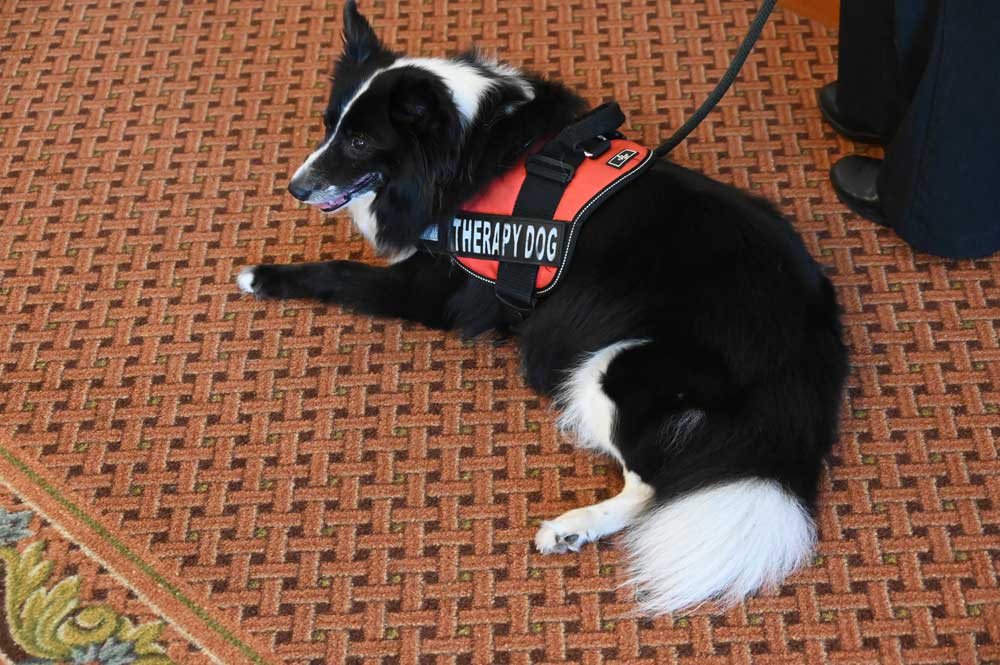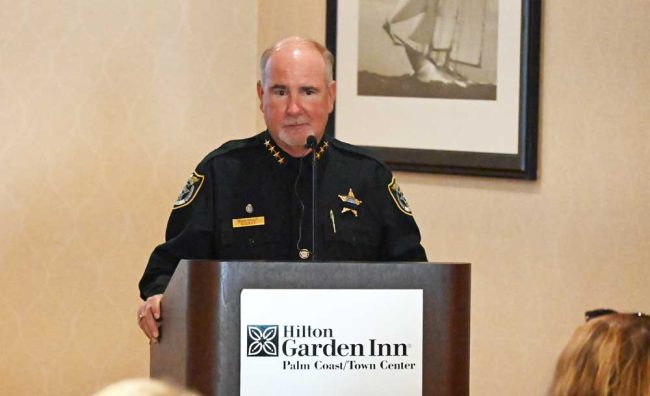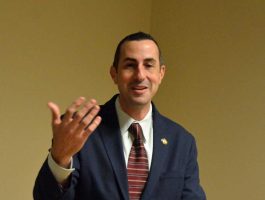
Domestic violence–family violence, intimate partner violence–is often the most challenging sort of crime for law enforcement and prosecutors, because perpetrators and victims are by definition in relationships. Pursuing cases is difficult when a victim doesn’t want to, and when a perpetrator can capably change, or twist, a victim’s mind. So it’s no the sort of problem that just goes away. The latest numbers in Flagler show how: the trend is down, but with one exception, not dramatically so.
After taking office in 2016 Flagler County Sheriff Rick Staly made countering domestic violence one of his central initiatives, standing up “summits” that engaged numerous civil sectors that intersect with victims and perpetrators of domestic violence–the domestic violence shelter, the clergy, the humane Society and others–along with law enforcement and the justice system.
After a Covid hiatus, Staly hosted the latest summit today at the Hilton garden Inn, where much of the discussion centered on changes that have taken place since 2016, and more especially since 2018: how the so-called red-flag law now plays a role in the gravest domestic violence cases, and how therapy dogs can be the difference between a witness cooperating, or opening up, and not.
There were also the numbers.
“We’ve made a lot of progress in the last four years with spousal domestic violence events down 19 percent since we started our first task force, and aggravated assaults involving spouses are down 50 percent Since 2017,” Staly said.
“There was a little bit of an increase during the pandemic, but so far this year the numbers are again down in comparison. But let’s keep in mind that that is reported domestic violence, because we also know that that a lot of domestic violence goes on behind closed doors that does not get reported until, unfortunately, something very violent occurs. Our reports and arrests declined a little bit during a pandemic but they’re going back back up now.” The discrepancy between incidents’ decline and reports and arrests rising may be related to the addition of charges for pre-trial violations.
Cmdr. Jennifer Nawrocki has been the point person on the initiative from the sheriff’s end, with a detective and a crime analyst assigned to the task. She summarized the numbers and trends: 619 total reported domestic violence offenses in 2018 compared to 581 last year, 134 spousal offenses compared to 109 in the same time span, and 25 aggravated assaults between souses in 2018, compared to 12 in 2021. So far this year domestic violence arrests are up over the numb er four years ago, 175 compared to 161, but down from last year’s 181.
Staly spoke of the state’s red-flag law on two occasions. Floridians, like the rest of America, are quickly becoming familiar with red-flag laws–laws that give government the authority to seize an individual’s weapons, including firearms, in certain circumstances, as in the more violent domestic violence situations. But they may not know that Florida passed just such a law in the aftermath of the Parkland massacre in 2018, and that what’s called risk-protection orders initiated by law enforcement agencies are now, if not routine, at least frequent in local courts: a law enforcement agency may seize weaponry, but it must then start the risk-protection order process and justify it in court.

It’s not necessarily a given that a judge will concede, and there’s not yet enough data to know how risk protection orders go. But Staly stressed the importance of such tools, and the governor’s signature on a law that expands their applicability. Staly tied the urgency of doing so to a startling number: 83,000 domestic violence injunctions are issued in Florida every year.
If risk-protection orders remain less than visible for the moment, an emerging strategy in anti-domestic-violence efforts is more so, and one of them was in the room: Dottie the therapy dog.
Nawrocki spoke of the agency’s three such dogs, which started to make their appearances at the department in 2019. “We use them for many different areas throughout the department–domestic violence victims, children of child abuse,” Nawrocki said. “We use them for children and different sex abuse situations where they sit with them while they’re getting interviewed by a forensic interviewer. They are very calming to have around the office and a lot of us when we have a serious stressful day going on, it’s actually nice to sit with the dogs for a minute, sometimes more than co-workers, they are a lot more relaxing and enjoyable.”
Det. Annie Conrad presented Dottie as she spoke of her own 17 and a half years in the department, most of them as a detective, and currently in major cases–meaning the most serious crimes. Conrad spoke of the frequent difficulties in breaking through to witnesses and have them open up in those difficult cases. Therapy dogs have been key. “I’ve actually witnessed myself a victim who was having a very hard time giving a statement, literally hold the Chihuahua, break down in tears and just let it flow. There’s a lot of reasons behind that, a lot of scientific reasons even as far as what animals do for us as emotional support,” Conrad said. “So I think we’re starting to finally see the benefits and how much they actually accomplish.”
She could see her own dog, Dottie, essentially “work the room” in situations, sensing where the stresses are and nudging her way to them to relax an individual, children especially. She’s been taken to courtrooms to wait with families whose children have to testify, and worked her magic there. “We have sentencing hearings where there’s families in the courtroom, and then sometimes all the way in the hallway, and they’ll come out and I’ve had people collapse on Dottie,” Conrad said. I’ve had them hug her. It’s just it’s amazing how it changes people and again bridges that gap that I just couldn’t seem to get a grasp on.”
Conrad adopted Dottie as the result of an incident that involved her former owner chaining her and misunderstanding her, and threatening an animal control officer who was investigating. Conrad convinced him to turn over the dog. The dog was certified. “She has been giving back ever since,” Conrad said. “She is amazing.” But she is also getting ready to retire. Her replacement, Teddy, is in training. He is five and a half months old. He’s already had his introductions at the State Attorney’s Office, and engaged with numerous children.
In a related update, Amy Carotenuto of the flagler Humane Society spoke of how animal and domestic abuse often parallel each other. “Why do people abuse their animals? For the same reason that they abused kids,” she said. “It can just be the way they were raised. They don’t know any better. Sometimes it’s culturally accepted. But our cases end up being a lot of the same as what those on the frontlines see.”
The summit was of course intended to provide the latest overview from different sectors of those involved (the initiative led to various committees). Among others, the Sheriff’s Office chaplain provided an update on faith-based initiatives, with a focus on how clergy is learning to “respond appropriately to situations of domestic violence” in their communities. “So we’ve spent a lot of time on educating clergy. Now we’re shifting to sharing information, disseminating, disseminating information to faith communities. We’re inviting them to post material within their church setting so that victims of domestic violence know where they can reach out to help.”
Trish Giaccone, who heads the Family Life Center, the county’s only domestic violence emergency shelter, spoke of new legislative requirements that go beyond batterers’ intervention programs merely existing. “No, we have to have a consistent program out in the community, making sure that people who are saying they’re doing this work are actually doing this work,” Giaccone said. “And it’s one step closer to holding perpetrators accountable.” There is also a shift afoot from focusing on seeking changes in victims’ behavior to changes in the behavior of perpetrators of violence, “get them engaged in substance abuse classes, and other entities that are going to be beneficial for the family. It’s really an effort to help families become as healthy as they possibly can.”

Because it’s not just about punishment, but often, and preferably, about repairing families–if the violence stops. “We always think in criminal justice that the goal was just to lock people up and throw away the key,” Assistant State Attorney Jason Lewis, who prosecutes major crimes, said, speaking on behalf of State Attorney R.J. Larizza. “But the reality is sometimes there’s other solutions, and with the Family Life Center, we try and get those services to folks who maybe don’t want us to prosecute or want to go back to a situation where maybe with a services it might work.”He said his offices’ most challenging cases to move forward are domestic violence cases, since often the victims end up dropping charges or refusing to press them–on a spouse, a sibling, a partner. Or else it’s violations of pre-trial conditions, with perpetrators pressuring their victims to drop cases. There is an occasional silver lining.
“I’m going to knock on wood because here in Flagler we’ve been lucky recently, we haven’t had a lot of domestic battery related murders,” Lewis said. “But I can tell you across the circuit, we’re at it probably about 20 to 25 percent of our murders are related domestically.”
![]()
See the summit’s presentation:
DV Summit PP - June 2022 (1)




























joseph hempfling says
dogs are not called man/woman’s best friend for no reason ! and having owned a Dalmation for
sixteen years while living in the Bay Area during the tumultuous SIXTIES can tell you firsthand
how Sundance, her name, got me through thick and thin always followed by a reassuring wag of her tail.